For those of you with the Rubicon Express lift (or RE lower control arms), you know they use what they call the “Superflex 2 Cartridge”. They provide a fair amount of rotation at the end of the control arm (compared to the rubber bushing at the other end of the arm). As with most items on your TJ, you need to maintain your equipment and the RE c-joints (what I call them) are no exception.
Now, I rarely (if ever) run in the mud…..Arizona just doesn’t get that much moisture here on the low desert where the majority of my wheelin’ takes place. I have no first hand information as to how these c-joints hold up in a mud rich environment. I can say that they do pretty well here in Arizona.
While I was doing normal maintenance (in this case, it was an oil change and lube), I noticed that I could not get one of the grease fittings on a lower control arm to take any grease. I didn’t have time to deal with it right then, so I took my spare set of RE lower control arms and put them in. I would figure it out later.
Later came this past weekend and I figured it was time to take a look in the c-joints and see if anything was wrong. I didn’t remember which control arm I had problems with (yeah, I know, I should have marked it) so I simply grabbed one and started working on it.
The first thing I did was to remove the grease fitting. Once it was removed, I hooked the grease gun up to it to make sure it was working correctly.
I should comment that there is an easy way and a more challenging way (if you don’t have a good pair of snap ring pliers) to take the c-joint apart. Not having done it before, I did it both ways and caused some extra steps for myself. However, no harm, no foul. I’ll show you everything I did and you can decide what you want to do.
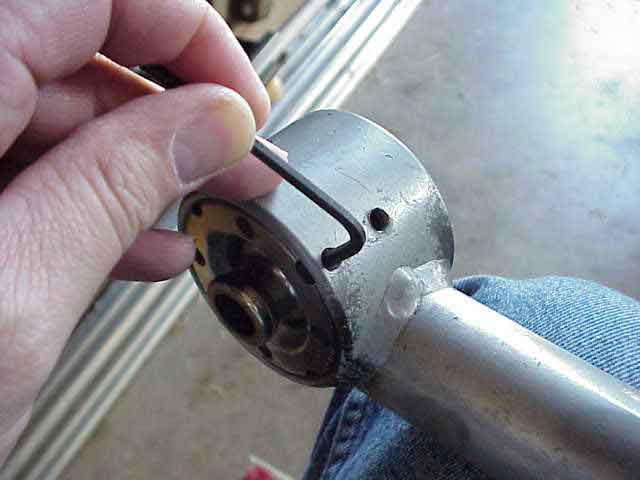
Using a standard allen wrench, remove the set screw in the c-joint as shown above. Note that the grease fitting has already been removed.
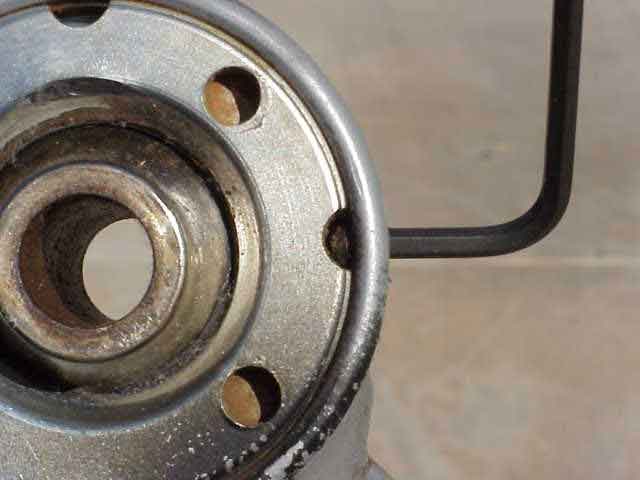
Here is another view that more clearly shows the set screw in the c-joint. There are 4 of these notched areas. When you reassemble the c-joint, you must align one of these 4 notches so that the set screw can be installed. This is necessary so that the screw in retainer will not work its way loose.
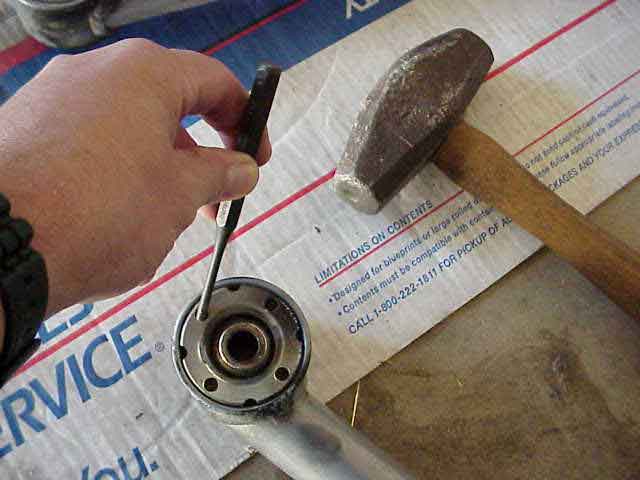
Now common sense there has to be a spanner wrench that properly fits either two or all four of those holes…..but I just didn’t seem to find one in my tool box. I decided to use a drift punch to loose the screwed in retainer. It was not screwed in that tightly (after all, the c-joint inner must be able to rotate). I few light taps with the hammer and it came loose. I suppose that if you live in the rust belt, this may be more of a challenge. When I put these back together, I am going to use some anti-seize compound on the threads, just to be safe.
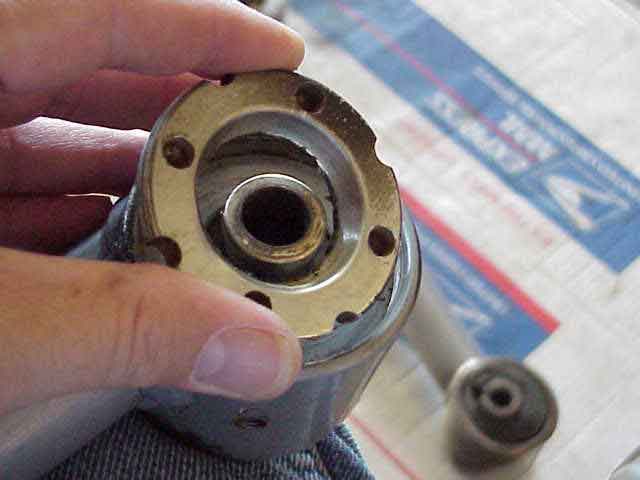
Unscrew the retainer ring and remove it from the control arm.

If you now flip the c-joint over, you will see the snap ring on the reverse side. Since I didn’t quite know what I was doing at this point, I decided the snap ring needed to be removed so I could fully disassemble the c-joint. Wrong….I could have gotten away without doing this. Since this is a HEALTHY snap ring, I would not recommend you taking it out if you don’t need to.
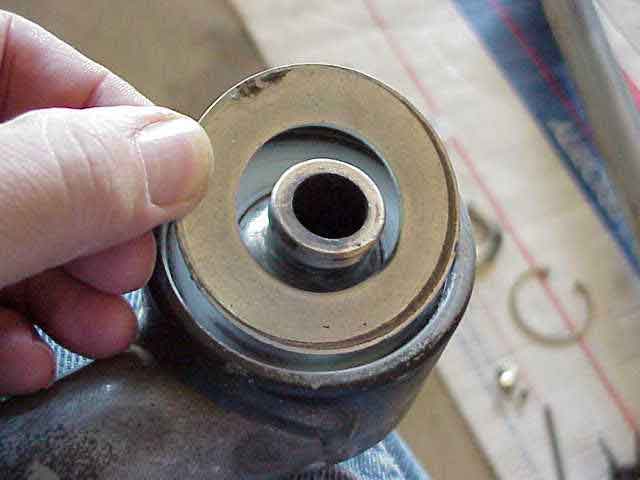
But IF you were so inclined to remove the snap ring, then you will also want to remove this thick washer that lies right underneath it.
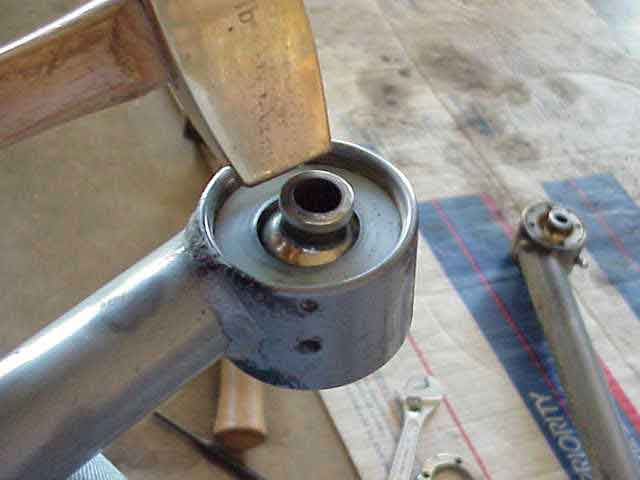
I next used a brass hammer to gently tap the ball assembly out of the control arm. Note that this can be done regardless of your removing the snap ring or not. Had I not removed the snap ring, I would have been doing it the same as shown in the photo above. As you tap, the ball will push the nylon block out the other side of the control arm.

With the one nylon block removed, you can easily inspect the ball and both of the nylon blocks it rides in.

Clean the ball and nylon blocks completely before inspecting them. I used some WD-40 to cut through what little grease there was (I think this is the one that was having trouble taking grease). After cleaning the components, check them thoroughly. You would be looking for scratches or gouging on the metal ball. If you see it there, you will certainly see them on the nylon blocks. Mine looked to be in good shape. Some of the grease/grime was really stuck on the ball. I soaked it a bit with some WD-40 and it finally cleaned up OK. I checked the nylon blocks and although they had a tiny bit of scuffing in a couple of places (this was where the that was stuck on the ball had been rubbing), they too were in good condition and would be put back into service.
Assembly is the reverse of disassembly. After everything was back inside (with a light coating of grease), I screwed the retainer back into place. I used the drift punch to gently tighten things up. How tight? I used the other assembled c-joint as a reference and just snugged the retainer ring down until both felt the same (amount of effort needed to rotate the ball) and the notch lined up properly so the set screw could be tightened.
Update 2/24/2006: I received an e-mail from MarkO, a fellow Jeeper that is in the Navy. He sent me the following information in regards to the maintenance and rebuilding of the RE joints. He said….
I recently rebuilt my RE control arm joints, but since I didn’t notice the write-up on your site, I called RE instead. Now that I’ve read the write-up, I’d like to point out some minor differences between what the RE tech told me and your procedure.
First is when tightening the joint after clean/rebuild is complete, he told me to get it as tight as possible. The inexpensive tool they sell to work on these has a 1/2″ socket drive, and he confirmed I could use my impact to get it tight, just keep going until the setscrew holes line up. I asked about a torque spec, he said there isn’t one. RE said I could tighten 3-4 times before rebuilding with new races, about $10 for a set. Of course I would recommend complete tear down and inspection, not just blind tightening. The part numbers for the joint tools are RE3771 and RE3772 for small and large joint respectively. About $20 each online from various retailers.
Second is about greasing, when tight and new, they should take very little if any grease. The soft material of the bearing race compressed against the smooth chrome ball is what provides both the lubrication and the correct amount of resistance. When it becomes real easy to grease, that indicates that the tolerance between the two surfaces has increased, thus indicating they need to be tightened again. This too was verified with tech support at RE. (The joint design is very similar to the ball valves in the old twin agent fire fighting system you may remember from your Navy days.)
